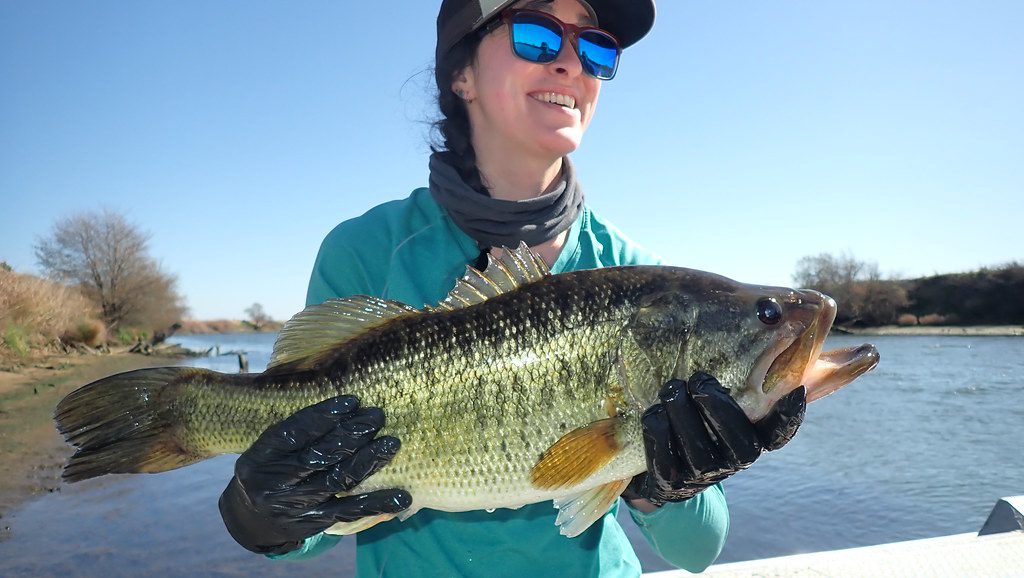Monday November 2, 2020

For juvenile Chinook salmon (Oncorhynchus tshawytscha) migrating through the Sacramento-San Joaquin Delta, hungry non-native predatory species pose a threat to their survival. However, disentangling the effect of predation from other threats to salmon survival is exceedingly difficult. Predation is often studied either in an unnatural laboratory setting where scientists have total control over the environment, or in a natural system where scientists have no control over the environment. To bridge this gap, a group of researchers recently developed a compromise between a controlled laboratory and chaotic natural setting. By constructing an experimental enclosure along a riverbank, they could control numbers of predators and prey, evaluate the effects of different habitat features, and still provide natural environmental conditions (Zeug et al. 2020). Their findings published in the journal Estuaries and Coasts highlight that non-native aquatic plants may increase predation risk of juvenile salmon.
Predation has been posited as the primary cause of juvenile Chinook mortality in the Delta. Not only are non-native predators abundant, but predation risk may be compounded by the increasing prevalence of invasive aquatic vegetation such as Brazilian waterweed (Egeria densa). These non-native plants may deal a double blow to Chinook by both restricting their access to formerly open-water habitat and by providing predators like largemouth bass (Micropterus salmoides) an edge in a habitat they are well-adapted to. Notably, the abundance of largemouth bass in the Delta has increased alongside the proliferation of invasive submerged aquatic vegetation. Similar to water weeds, artificial structures like docks and piers may also act as predator hotspots. Until now, testing the relationship between these two human-created habitats and predation, as well as the relationship of predator densities to predation risk, has been a tricky needle to thread, which underscores the significance of this recent study.
The enclosure developed for the study was placed along the bank of the South Fork Mokelumne River in the Central Delta, a location characterized by tidal fluctuations, abundant non-native aquatic plants, and docks. The enclosure consisted of three, linearly arranged cubes connected by netting, designed so that only the Chinook smolts could move from one enclosure to the next. The connections between each enclosure were equipped with passive integrated transponder (PIT) antennas to detect tags that were implanted into the Chinook, thereby providing data on fish movement. Each of the three compartments included a unique treatment. In the first experiment, the treatments were predator densities of three, six, or 12 largemouth bass. In the second experiment, the compartments were modified with artificial water weeds, a dock-like structure made out of plywood, and left as open water, respectively. Each of these different habitat compartments contained six largemouth bass. After 24 hours, all fish were collected, bass stomach contents were analyzed to assess predation, and PIT detection data were used to assess Chinook movement.
The results indicated that predation of Chinook smolts was highest at the medium predator density (six largemouth bass per enclosure), whereas there was little difference between predation rates in the low- (three bass) and high-density (12 bass) enclosures. The findings also strongly supported the hypothesis that non-native aquatic plants increase predation risk, as Chinook in the artificial water weeds enclosure suffered the highest mortality. However, there was no significant difference between predation in the enclosure with the dock and in the open water enclosure. This study yielded two important insights. First, submerged aquatic vegetation (which is now estimated to cover 22% of the Delta’s water surface) may be an important target for restoration efforts, as it appears to have a significant influence on Chinook predation risk. Second, preexisting predator density may be a critical consideration for any predator removal efforts, as the relationship between predator numbers and predation does not appear to be linear. As other studies have shown, removing predators to improve survival of prey species often yields inconsistent outcomes that depend on the context. The authors suggest that removal of invasive aquatic vegetation may be a more immediately beneficial action, and studies focusing on assessing the impacts of such habitat restoration efforts are an important next step. However, in a system as big and diverse as the Delta, there is no one-size-fits-all approach to reducing predation, and the best plan of action will depend on the site and predators in question.
This post featured in our weekly e-newsletter, the Fish Report. You can subscribe to the Fish Report here.
